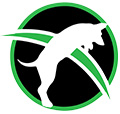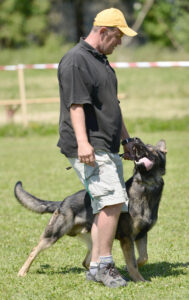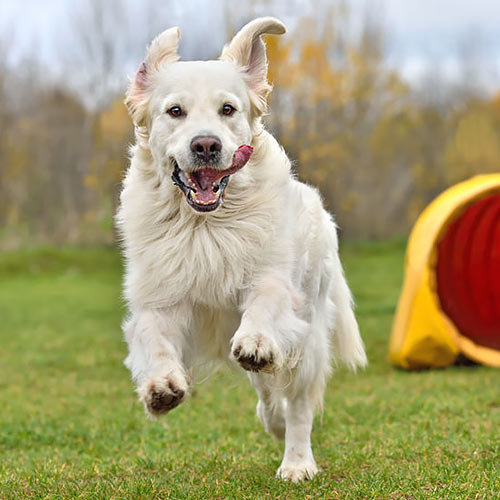Nothing about dog training is automatic.
Some people are of the mistaken mindset that domestic dogs can simply perform as we want them to without any responsibility or direction on our part. This mindset is a farce!
A dog’s behavior is nearly always a reflection of his human. If the human permits sloppiness in the dog’s training, the dog will be sloppy. He will seek out what he can exploit, and use it to his advantage. If the human requires obedience (or non-aggression, or releasing the bite sleeve or toy the first time he’s told, or any number of other issues), the dog will respond and rise to that level. Excellence travels down the leash! If excellence is to be present, it must start with you.
“If the human requires obedience, the dog will respond and rise to that level.”
Dogs need our leadership. They crave it. They are hard-wired to live within a pack structure. As a social pack animal, they need that structure. Without it, they can become unbalanced, anxious, fearful, and can even become aggressive. So many dogs fit into this category; many of them are there unnecessarily! It is a human-caused problem that we, as the human, should seek to solve.
No amount of training will overpower lack of leadership. If the dog is to continue well in his training, the owner must rise to the level of leadership that the trainer utilized to get things done with the dog. If you are a part of one of our training packages, we will help you in making this happen – through education and follow-up.
One word of advice here. Do not humanize the dog. It is not your four-legged son or granddaughter. Let him/her be a dog. Your love for the dog is what compelled you to take one into your home. It is demeaning and unnatural for dogs to be treated as humans. We’ll leave the bulk of this subject to another article.
Thankfully, the days are almost gone where humans tied their dogs on a chain in the back yard. As positive as that change is, it is taking a much longer time to educate people how to properly interact with dogs, how to bring out the best in the dog.
For there to be harmony in the human-dog relationship, the arrangement of the social structure must be a healthy one. Dogs view humans in one of our ways.
- They may view their human as an equal. Our respect/love for the dog sometimes compels us to treat them as an equal. This is detrimental. Equality of rank will always produce problems in the relationship. In fact, in a canine pack, equality of rank is where the vast majority of aggression takes place. Treating the dog as an equal will damage your relationship. The human has superior intelligence…act like it. It’s okay to tell your dog “no” when needed. Your superior intelligence knows it is in his best interest to not run across the highway. Your correction saves his life.
- They may view their human as an inferior. Frankly, many dogs are much smarter than their humans. These dogs look down on their humans. Dogs can pick up on this very quickly. Humans are much slower to catch on to what is going on. A dog who views his human as inferior will do his own thing instead of listening to the human and obeying the human in his obedience work or other performance. Sometimes these dogs are smart enough to figure out how to get their own way by outsmarting the human. They train the human instead of the human training the dog.
- They may view their human as a superior. Humans who establish their leadership in the dog’s mind will have fewer behavior problems in the dog and much less trouble in obedience work and other types of work. These dogs look up to their humans for leadership, guidance, and structure. This leadership is to be what we call, Firm and Fair. That is, realistic expectations coupled with steadfastness. True leadership is not mean or harsh.
- They may view their human as an enemy. When we speak of leadership, we are not speaking of harshness, brutality, yelling, screaming, yanking, beating. That is not leadership. That is cowardice (at worst) or ignorance (at best) expressing itself forcibly. This type of so-called “leadership” is counter-productive because it hinders positive learning. It is counter-productive to establishing healthy rank as well, because it creates enmity and even repulsion toward the human. The human becomes the enemy. This type of relationship with a dog is certainly an unhealthy one. If this “bully” type is your view of leadership, you will have rethink the situation (and educate yourself) in order to provide the social structure we are talking about here.
Human leadership shows itself in how we interact with the dog in many situations. For example, when a dog is timid around new environments or new people. Our leadership calmly acts as though nothing has changed. Our tone of voice, the commands that we give, as well as us not catering to the dog’s timid behavior will all help the dog to work through these situations. Leadership doesn’t pet the dog or tell him it’s “ok” when he’s timid – this actually makes the situation worse. Instead, reward the dog when he/she is acting calm. This lets him/her know what behavior is expected instead of making things worse.
Human leadership expects the rules to followed even if surroundings change. In other words, there is not one set of rules when only the dog’s family is in the house and another set of rules when company comes over. The rules are the same in either situation. Heel still means Heel. Stay still means Stay. Leave it still means Leave It. If a dog senses a change of rules and expectations, he will seek to find those boundaries on his own – probably in ways that you wouldn’t be pleased with. The rules are same whether we’re walking along the yard or when a squirrel runs out in front of us. The rules are the same if there is a tennis ball nearby or not, if there is a bite sleeve nearby or not. This is leadership. If the dog perceives that the rules change, he will exploit that change – usually to his own advantage and to our chagrin.
Again, the dog will rise or sink to your level of expectation. Give him something to look up to, and he’ll be a companion that strives to meet those expectations.


